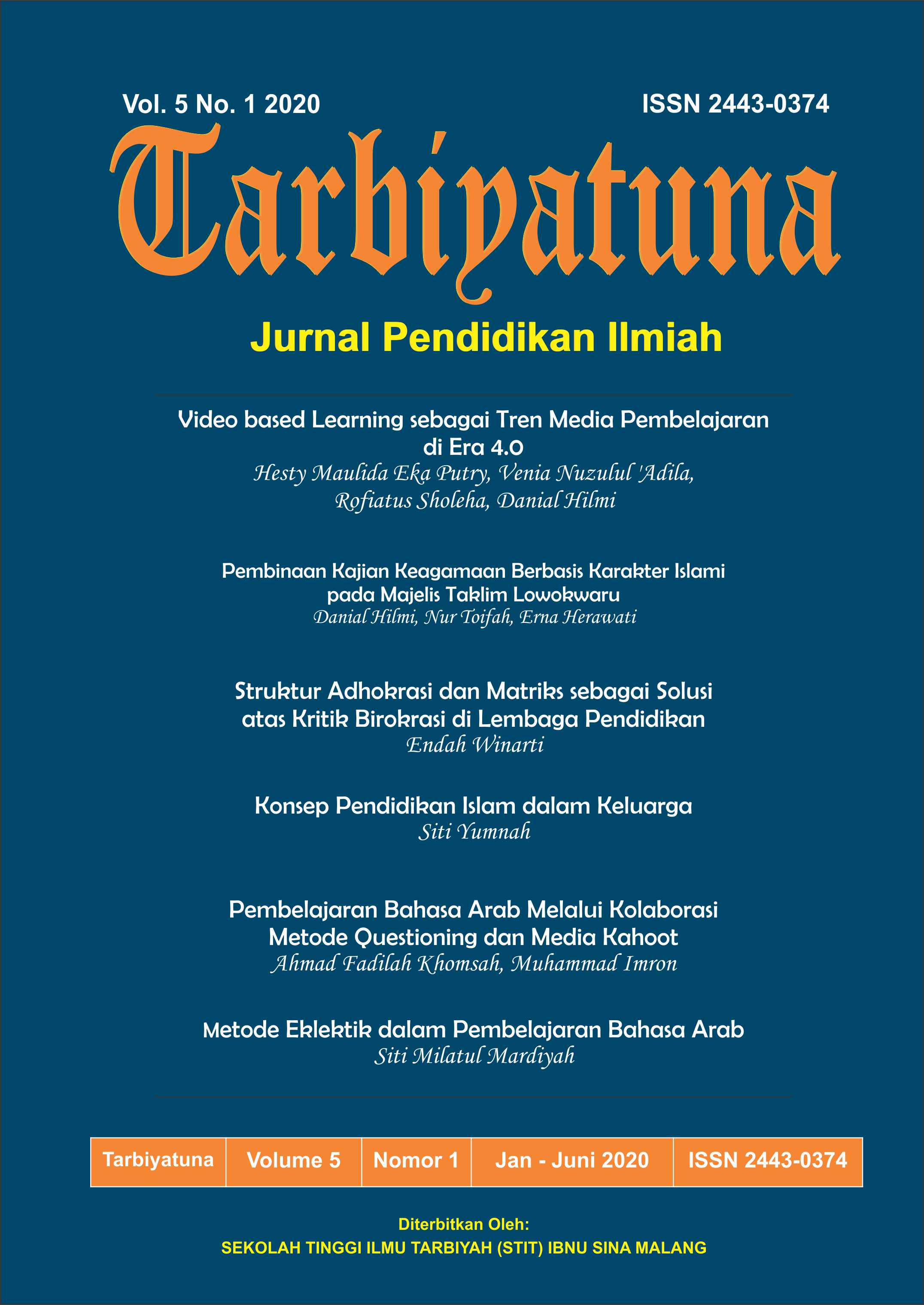Struktur Adhokrasi dan Matriks sebagai Solusi atas Kritik Birokrasi Di Lembaga Pendidikan
Abstrak
Tantangan kemajuan teknologi dan globalisasi, telah menuntut lembaga-lembaga layanan publik, termasuk institusi pendidikan, untuk terus berinovasi dan memperbaiki diri mengikuti perkembangan zaman. Di sisi lain, birokrasi yang digunakan saat ini kurang fleksibel dan inefisiensi hingga memunculkan banyak kritik, yang menunjukkan ketidakberdayaan birokrasi jika berhadapan dengan tantangan zaman. Kritik-kritik tersebut menghadirkan bentuk baru: adhocracy dan organisasi matriks, yang menghadirkan fleksibilitas dalam struktur organisasi. Artikel bertujuan menghadirkan solusi mengatasi kritik birokrasi dengan mengintegrasikan adhokrasi dan organisasi matriks dalam birokrasi di lembaga pendidikan. Integrasi ketiga bentuk struktur organisasi tersebut, diharapkan dapat menjadikan institusi pendidikan menjadi fleksibel dan efisien untuk dapat bertahan dalam berbagai tantangan zaman.
Referensi
Bennett, Paul W. “Consolidation, Bureaucracy and The Public Schools: The Formation of The Modern Bureaucratic Education State, 1920 To 1993â€, Canadian Issues – Spring. 2014. pp: 16-22.
Blau, P. M. Bureaucracy in modern society. Crown Publishing Group/Random House. 1956.
Bohte, John. "School bureaucracy and student performance at the local level." Public Administration Review 61(1) 2001. pp: 92-99. https://doi.org/10.1111/0033-3352.00008.
Bush, T. Theories of Educational Management. International Journal of Educational Leadership Preparation. 1(2) 2006.
Caiden, G. E. What really is public maladministration?. Public Administration Review. 1991. p. 486-493. https://doi.org/10.1177%2F0019556119910101
Dolan, Timothy E. “Revisiting Adhocracy: From Rhetorical Revisionism to Smart Mobsâ€, Journal od Future Studies, 15(2) 2010. Pp. 33-50.
Easterly, William. "The cartel of good intentions: the problem of bureaucracy in foreign aid." The Journal of Policy Reform 5(4) 2002. pp: 223-250.
Haffar, Mohamed, Wafi Al-Karaghouli, and Ahmad Ghoneim. "An empirical investigation of the influence of organizational culture on individual readiness for change in Syrian manufacturing organizations."Journal of Organizational Change Management, Vol. 27(1) 2014. pp: 5-22. https://doi.org/10.1108/JOCM-04-2012-0046
Hardjito, Dydit. Teori Organisasi dan Teknik Pengorganisasian. Jakarta: Raja Grafindo Persada. 1995. Cet. III
Howard, Philip K. "To Fix America's Education Bureaucracy, We Need to Destroy It". The Atlantic. 2012. https://www.theatlantic.com/national/archive/2012/04/to-fix-americas-education-bureaucracy-we-need-to-destroy-it/255173/
Javadian, Golshan and Isaac Y. Addae. "The impact of bureaucracies and occupational segregation on participation of Iranian women in the workforce." Equality, Diversity and Inclusion: An International Journal 32(7) 2013. pp: 654-670. https://doi.org/ 10.1108/EDI-08-2012-0067
Jull, Stephen. K. Locating gender bias and systemic discrimination in public schooling bureaucracy.Alberta journal of educational research, 48(1) 2002.
Kusdi. Teori Organisasi dan Administrasi. Jakarta: Salemba Humanika. 2009.
Laegaard, Jorgen & Mille Bindslev. Organizational Theory. Ventus Publising. 2006.
LeMay, C. Michael. Public Administration : Clashing Values in the Administration of Public Policy. Thomson Wadsworth. 2006.
Mehta, Jal. "From Bureaucracy to Profession: Remaking the Educational Sector for the Twenty-First Century." Harvard Educational Review 83(3) 2013. pp: 463-488. https://doi.org/10.17763/haer.83.3.kr08797621362v05
Mintzberg, Henry. "Structure in 5's: A Synthesis of the Research on Organization Design." Management science 26 (3) 1980 pp: 322-341. https://doi.org/10.1287/mnsc.26.3.322
Nurkolis. “Potret Birokrasi pendidikan di Indonesiaâ€, JMP Vol. 2 (1) 2015, hlm: 44-55.
Ochrana, FrantiÅ¡ek, Michal PlaÄek, and Milan PůÄek. "Reasons for the Infectiveness of the Czech State Bureaucracy: Myths and Reality." Procedia Economics and Finance 30. 2015. pp: 622-630. https://doi.org/10.1016/S2212-5671(15)01275-7
Okotoni, Olu. "Problems and Prospects of Nigerian Bureaucracy." Journal of Social Sciences 7(3) 2001. pp: 223-229. https://doi.org/10.1080/09718923.2003.11892384
Owens, R. and C. Shakeshaft. “The new revolution in administrative theoryâ€, Journal of Educational Management, 30 (9) 1992. pp: 4-17. https://doi.org/10.1108/09578239210014432
Rais, Soenyoto. Pengelolaan Organisasi. Surabaya: Airlangga University Press. 1994
Thoha, Miftah. Birokrasi & Politik. Jakarta: PT RajaGrafindo Persada. 2007
Tim Dosen Ap. Manajemen Pendidikan. Yogyakarta: UNY Press. 2011
Unger, Jean-Pierre et al. "Through Mintzberg s glasses: a fresh look at the organization of ministries of health." Bulletin of the World Health Organization. 78(8) 2000. pp: 1005-1014.
Widaningrum, Ambar. Reformasi Manajemen Pelayanan Kesehatan, dalam Pramusinto dan Purwanto (ed). Reformasi Birokrasi, Kepemimpinan, dan Pelayanan Publik: Kajian tentang pelaksanaan otonomi daerah di Indonesia. Yogyakarta; Gaya Media. 2009
Winardi, J. Teori Organisasi dan Pengorganisasian. Jakarta: Raja Grafindo Persada. 2003. Cet. 1
Xi, Youmin and Xiaojun Zhang. “Replying to management Challenges: Integrating oriental and occidental wisdom by HeXie Management Theoryâ€, Chinese Management Studies, Vol. 6 (3) 2012. pp. 395-412. Emerald Group Publishing Limited. https://doi.org/10.1108/17506141211259104

